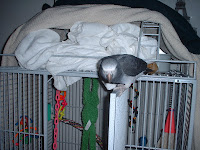 First came Rocky, a severe macaw hatched in 1987. He had been surrendered to the parrot rehabilitation center where we volunteer. He was discovered to have an enlarged preen gland, and his vet recommended treatment including soaking it several times a day and medication.
First came Rocky, a severe macaw hatched in 1987. He had been surrendered to the parrot rehabilitation center where we volunteer. He was discovered to have an enlarged preen gland, and his vet recommended treatment including soaking it several times a day and medication.Thomas and I decided to foster Rocky so that the volunteers at the shelter would not have to worry about his medication and soaking schedule. We had no intention of keeping him, but he loved it at our house and fell in love with Thomas. We officially adopted him several months later.
Rocky has kind of a sad story. He was loved very much by his previous owner, but when that man died, he was passed to a family member that didn't want him. He spent at least the 6 years prior to being released to the shelter locked in his too-small cage, with very few toys. And after living with Rocky for almost a year now, I can understand (but certainly not condone) keeping him in his cage. When Rocky doesn't like someone (and severe macaws rarely like more than one person), he chases them and tries to attack them. And for being a smaller bird, he has a vicious bite! I have since learned to read his body language and while I can't handle him (unless it's on a stick), I haven't received a bite since that first month. It is very important for parrots, especially macaws, to have hands-on attention, and Rocky gets that from Thomas.
 About a month later, I found out that a black-headed caique was being surrendered to the shelter. This little guy was about 8 years old. His previous previous owner was going to release him outside to his certain death because he bit her and sent her to the emergency room. A wonderfully kind family took him in for about 9 months, saving his life, but they didn't have parrot experience and were scared of him. They made the tough decision to surrender him to the rescue. Thomas and I have a soft spot for caiques, who are much more difficult parrots than their size would suggest! We took him home the same day he was surrendered.
About a month later, I found out that a black-headed caique was being surrendered to the shelter. This little guy was about 8 years old. His previous previous owner was going to release him outside to his certain death because he bit her and sent her to the emergency room. A wonderfully kind family took him in for about 9 months, saving his life, but they didn't have parrot experience and were scared of him. They made the tough decision to surrender him to the rescue. Thomas and I have a soft spot for caiques, who are much more difficult parrots than their size would suggest! We took him home the same day he was surrendered.We renamed him Beeps. Normally we like to give our parrots people names, but this guy beeped all of the time, and while we were waiting for his DNA-sexing to come back, we started calling him Beeps, which eventually stuck.
Beeps is an amazing parrot, and more proof that not all rescue birds have problems, especially in the right environment. We've had him over 8 months now, and he has never bitten us, rarely screams, talks quite a bit (although he only has 2 phrases that he keeps repeating), a voracious eater, wonderful toy-player, etc., etc. He also picked up clicker training very quickly and is now the parrot that I bring with me when I teach other people how to train! I am so thankful every day that he was saved from his certain death outside and brought home to us because we can't imagine our lives without him!














